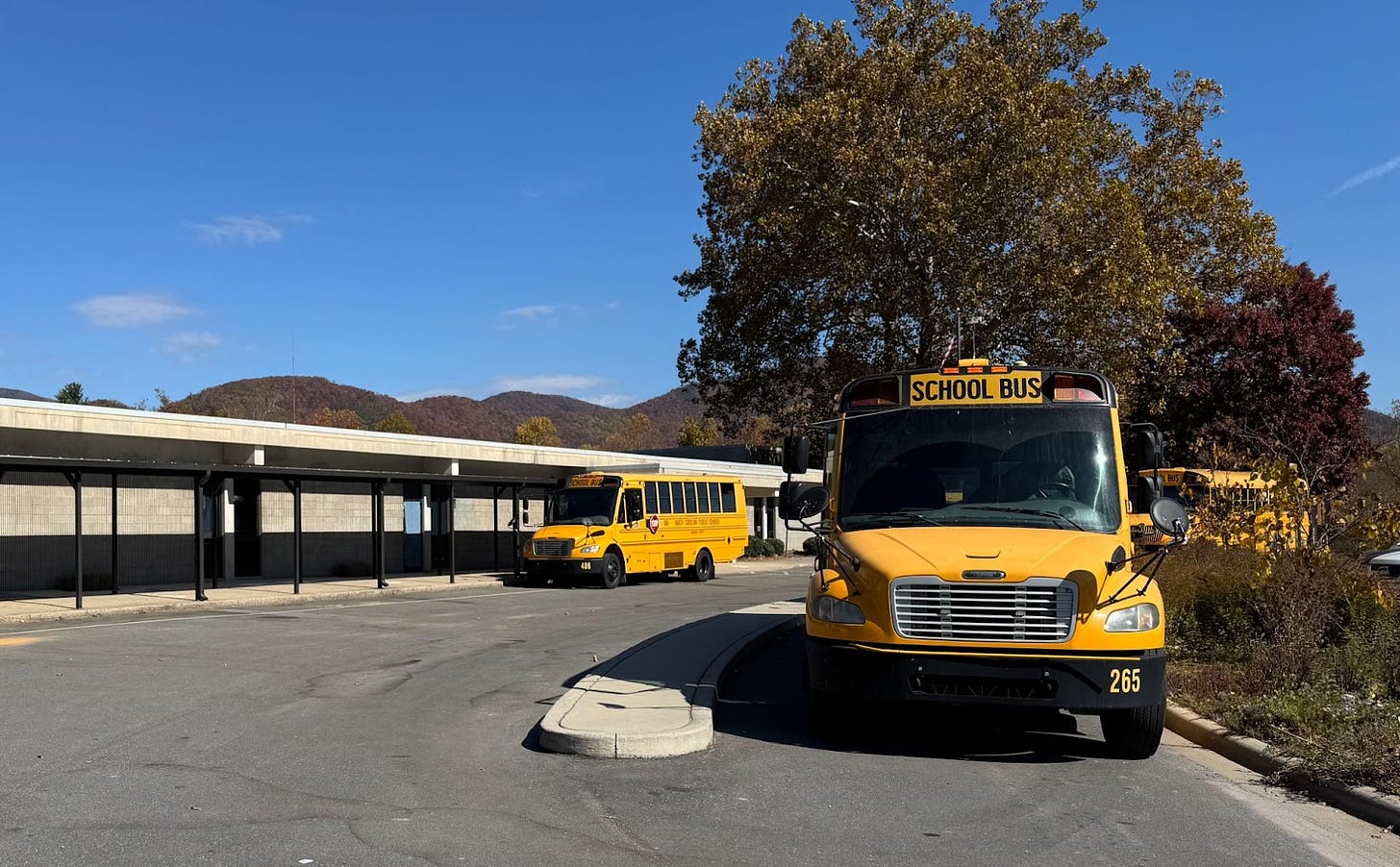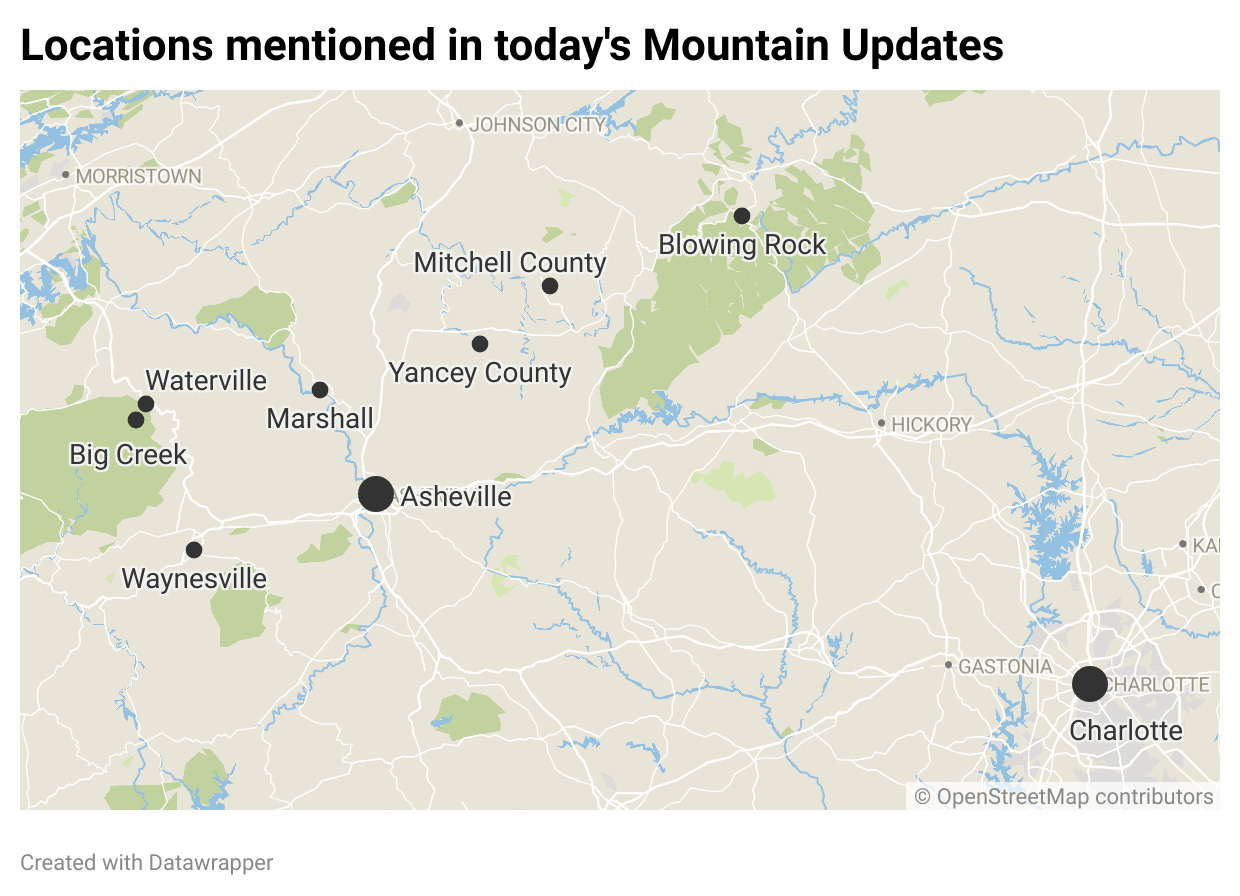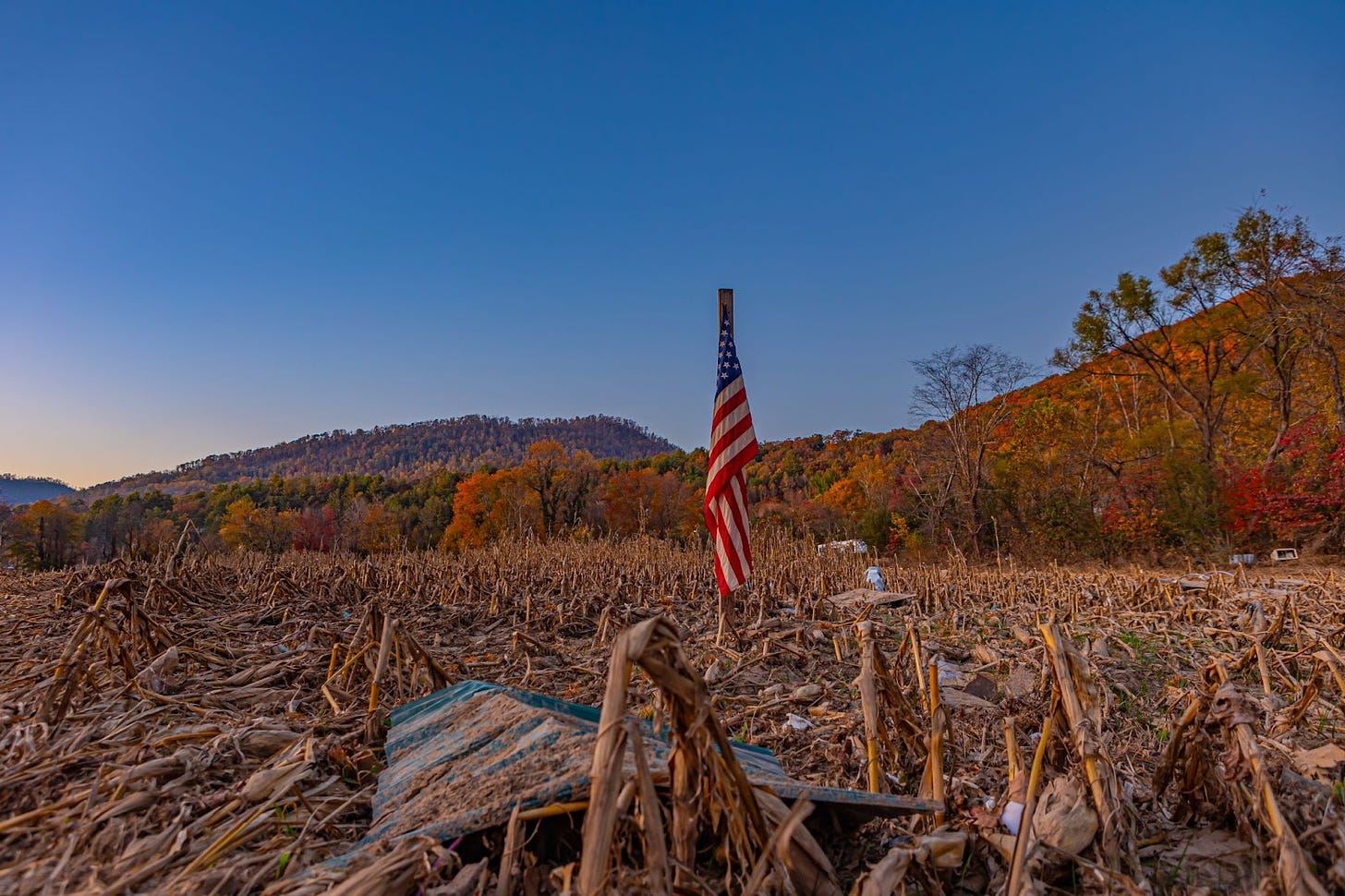Some mountain students return to school
Plus: Buncombe overcounts deaths; Section of Blue Ridge Parkway reopens; ‘Concert for Carolina’ kicks off tomorrow; Checking in on mountain wildlife
You’re reading Mountain Updates, a free pop-up newsletter from The Charlotte Ledger examining the crisis and recovery in the N.C. mountains. Ledger subscribers can add Mountain Updates on their “My Account” page.
Sign up for free:
Four weeks after Hurricane Helene hit Western North Carolina, the region welcomes any sign of normalcy. This week, in Buncombe and Watauga counties, that means returning to the classroom.
Buncombe County Schools started back today on a two-hour delay. Many students met this morning at one of the new community bus stops. They received packaged lunches. Toilets could be flushed, but students were advised to follow up their hand-washing with hand sanitizer. (There’s still sediment in the water that’s producing a yellow-brown color. My family has been using a camping shower to bathe every day.)
Black Mountain Primary School, pictured above, was one of 45 schools in Buncombe County that started back today. (Photo courtesy of Tanya Banks)
My mother, who’s a first grade assistant teacher in Black Mountain, went back to work on Wednesday. The teachers exchanged their hurricane stories, some brought to tears reliving the experiences of losing their homes and all of their belongings. Yet somehow, all the teachers are safe and returned to work.
Yesterday, my mother and her coworkers called each of their students to ask how they would be getting to and from school. Three of the students in my mother’s class will not be returning – they’re either being homeschooled or have moved away. Unfortunately, that’s not a huge surprise in some of the harder-hit counties.
Watauga County Schools started back yesterday, Asheville City Schools will reopen Monday and Avery County Schools is planning to reopen on Nov. 6, according to its website. Yancey and Mitchell schools are still closed.
But thousands of students are back in the classroom, and it’s a sign of progress. Repairs are still slow, supplies are still needed, and many folks are still in limbo. But the area is moving forward, free from the time warp that has been the past month. —Lindsey Banks
Here’s the latest news coming out of the region:
Buncombe County overcounts deaths: Buncombe County, home to Asheville, has adjusted its reported death count, lowering it from 72 to 42, in alignment with state data. The initial overcount was attributed to challenges in communication and classification of deaths during the aftermath of the storm. The state’s official review process by the Office of the Chief Medical Examiner has been determining the causes of death. This revision affects the overall count of fatalities from Helene, with the state count at 96 deaths in North Carolina. (Associated Press)
Why the media isn’t reporting on ‘thousands of deaths’: There isn’t proof, says state officials. The unofficial Hurricane Helene People Finder, created due to the storm’s disruptions, has over 4,000 entries, with around 600 still marked as missing. The North Carolina Department of Health and Human Services reported only 26 officially missing. Misinformation about missing persons has spread on social media, prompting officials to warn against unverified claims and urging people to rely on official sources for updates on the disaster. (Charlotte Observer)
Part of Parkway reopens: A 20-mile section of the Blue Ridge Parkway near Blowing Rock reopened this week, the first North Carolina section of the road to reopen. In Haywood County, Highways 276 and 215 have reopened, too.
Waynesville water is liquid gold: In response to the water crisis in Asheville, Waynesville has supplied over 380,000 gallons of its water, delivered by tanker trucks to various facilities, including FEMA camps. The town, equipped with a protected reservoir and treatment capacity, is currently providing the water for free and is tracking usage for future reimbursement from FEMA. Waynesville is fortunate to have a robust water supply, and neighboring Clyde has also begun sourcing water from them due to issues with its previous supplier. (The Mountaineer)
Swannanoa was ‘ground zero’: In Swannanoa, east of Asheville, residents like Thanh Bui and her son were forced to swim to safety. The storm resulted in record rainfall and river levels, leading to widespread property damage and loss of life. The valley's geography contributed to the flooding, raising concerns about future risks in the community. (Asheville Watchdog)
911 calls going to Tennessee: The communities of Big Creek and Waterville in Haywood County are having their emergency calls routed to Tennessee because the closure of I-40 has cut them off from the rest of the county. (The Mountaineer)
Concert for Carolina: The Bank of America benefit “Concert for Carolina” is happening tomorrow at 5 p.m. and will feature headliners Luke Combs, Eric Church, Billy Strings and James Taylor. The concert can be streamed online here.
How did Helene affect the environment?
Western North Carolina prides itself on its nature and wildlife. Hurricane Helene has severely disrupted its health.
The storm's aftermath will likely alter ecosystems for decades, according to Falyn Owens, a wildlife extension biologist at the North Carolina Wildlife Resources Commission. The Asheville Citizens Times breaks down the damage:
Increased sediment has affected water quality and harmed fish and amphibians. About 600,000 fish died at a state hatchery, and the eastern hellbender — a rare salamander, and the largest amphibian in North America — lost its critical habitat.
Terrestrial species, like deer, raccoons and coyotes, might be less impacted (essentially because they can run away from storms), though some bird populations were displaced. Many bats also lost their habitats when bridges were swept away.
The fate of other at-risk species, like the southern bog turtle, Hickory Nut Gorge green salamander and the Carolina northern flying squirrel, are unknown by scientists at this time.
The holes left in downed trees and washed-away vegetation have left room for invasive species to proliferate, further complicating recovery efforts.
Thousands of farms were in Helene’s path, including more than $600 million in crop production value, according to the American Farm Bureau.
Comprehensive assessments are still ongoing, but full recovery may take decades.
Encouraging toxic soil results: In Marshall, out of 135 pollutants tested by local nonprofit MountainTrue, only isopropyl toluene and trimethylbenzene were found, with trimethylbenzene not posing significant health concerns at current levels, the Asheville Citizen Times also reported. While cleanup workers are advised to take precautions, the findings suggest the situation isn't as dire as feared.
Governor signs 2nd relief bill; more to come
Gov. Roy Cooper signed a $604M relief bill for hurricane recovery in Western North Carolina on Friday morning. It’s the second such measure from the state, and more are expected. The General Assembly unanimously passed the bill on Thursday.
Here’s the breakdown from Raleigh TV station WRAL of where the bulk of the money is going:
$100 million for water and wastewater infrastructure repair loans
$100 million for cash flow loans to local governments
$75 million to match federal disaster relief funds
$50 million to help local and state governments address “unmet needs” not covered by insurance
$50 million for repairs to damaged public schools
$50 million for bridge loans for small businesses
Cooper said in a statement:
Western North Carolina needs significant investments to recover fully from the worst storm our state has ever seen. Legislators have taken a small step here and should follow it with a more comprehensive package to help families, businesses and communities build back stronger.
Cooper’s administration has said that the estimated costs of damage and recovery are at least $53 billion.
Photo of the day: Peak leaf season is here
Hurricane Helene disrupted many things this fall – but not the leaves. Most of the Blue Ridge Parkway, which is a hot spot for leaf peeping, is still closed, but the changing leaves can still be seen throughout the region. This photo was captured in a cornfield, which was flattened by flooding. (Photo courtesy of Rey Castillo Jr.)
—
Lindsey Banks is a staff reporter with The Charlotte Ledger. Reach her at lindsey@cltledger.com.
—
Programming note: No. 2 official at FEMA interviewed about Western N.C. recovery on ‘Carolina Business Review’
Erik Hooks, the deputy director of FEMA, was interviewed on this week’s “Carolina Business Review with Chris William” about the recovery in Western North Carolina. Hooks is also the former secretary of the N.C. Department of Public Safety. The panel interviewing him includes Charlotte Ledger editor Tony Mecia and University of South Carolina economist Joseph C. Von Nessen. The program airs tonight at 8:30 p.m. on PBS Charlotte.
How to help
Many organizations have deployed groups across the region, tasked with distributing food, water and supplies. You can donate to their efforts at the links below.
Hearts with Hands, a local disaster relief organization, has a donation page to provide food, supplies and water.
United Way of North Carolina has established a fund to help residents affected by the flooding.
MANNA Foodbank, which serves 16 counties in Western North Carolina, is accepting food, supplies and monetary donations. The organization’s warehouse on Swannanoa River Road in Asheville was damaged by the hurricane.
The American Red Cross is accepting donations to help residents in the Southeast.
Samaritan’s Purse, which is headquartered in Boone, is scheduling volunteers to help with debris cleanup.
Operation Blessing has a donation page to provide food, supplies and water.
E4E Relief, a Charlotte-headquartered provider of emergency financial relief programs on behalf of corporations, is accepting donations for their newly established Hurricane Helene Community Fund, offering financial support to individuals with long-term impacts from Hurricane Helene.
Need to sign up for this e-newsletter? We offer a free version, as well as paid memberships for full access to all of our local newsletters:
➡️ Opt in or out of different newsletters on your “My Account” page.
➡️ Learn more about The Charlotte Ledger
The Charlotte Ledger is a locally owned media company that delivers smart and essential news through e-newsletters and on a website. We strive for fairness and accuracy and will correct all known errors. The content reflects the independent editorial judgment of The Charlotte Ledger. Any advertising, paid marketing, or sponsored content will be clearly labeled.
Like what we are doing? Feel free to forward this along and to tell a friend.
Social media: On Facebook, Instagram, Twitter and LinkedIn.
Sponsorship information/customer service: email support@cltledger.com.
Executive editor: Tony Mecia; Managing editor: Cristina Bolling; Staff writer: Lindsey Banks; Business manager: Brie Chrisman






